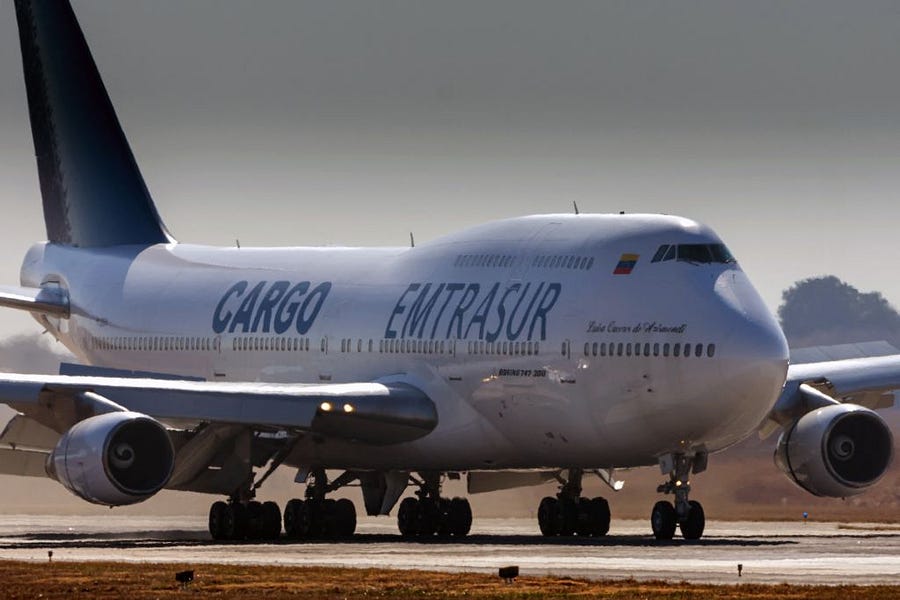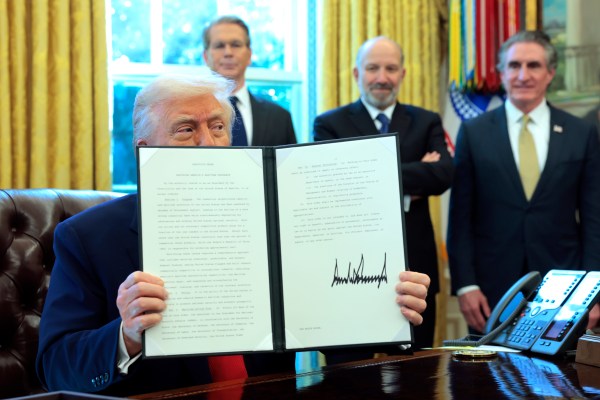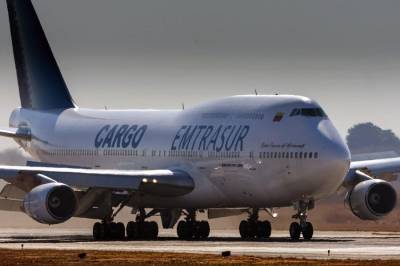On May 10, Paraguayan prosecutor Marcelo Pecci was murdered on a Colombian beach by hired assassins. As a high-profile member of the Office of Public Prosecution, he led Paraguay’s antinarcotics, corruption, organized crime, and terrorism finance investigations, prosecuting the most powerful criminal networks in his country. That included Hezbollah networks, which made him a target for the terror group as well as the powerful crime syndicates he sought to dismantle.
Three day later, a Boeing 747 cargo plane registered with Venezuelan airline Emtrasur made its way from Caracas to Ciudad Del Este, Paraguay, in the Tri-Border Area (TBA) of Argentina, Brazil, and Paraguay. There was no cargo on board, but the 18-member crew of seven Iranians and 11 Venezuelans included Gholamreza Ghasemi, a board member, shareholder, and manager of the U.S. sanctioned Iranian airline Fars Air Qeshm, the former chairman of Iran Naft Air (later renamed Karun Airlines) and, reportedly, a senior member of Iran’s Revolutionary Guard Corps, or IRGC. Ghasemi is a regime stalwart, not just a seasoned pilot, and since 2017, his airline, Fars Air Qeshm has been ferrying weapons and other military equipment to Damascus on behalf of the IRGC’s Quds Force. That a senior member of the IRGC in charge of such a sensitive logistical operation would be suddenly tasked to fly an empty cargo across the world is odd. What was he doing in Ciudad Del Este?
Before we answer that question, some background on Iran’s involvement in Latin America is helpful. Exporting the Islamic revolution has been a key goal of the Iranian regime ever since it toppled the shah in 1979. Latin America became an early target because Iran’s clerical leadership viewed the region as a fertile ground for the spread of anti-American ideology. During the past four decades, Iran has patiently pursued the goal of spreading its message across the Western Hemisphere and leveraged the resulting support in pursuit of its political goals.
To expand its influence, Iran has developed a dual track based on soft and hard power. Its soft power approach relies on a missionary network built on mosques, cultural centers, educational institutions, media outlets, and publishing houses, which it has sustained with both itinerant and resident clerics either from Iran or trained in Iran. This network has run in parallel with official diplomatic relations managed through embassies and other bilateral contacts, including intelligence and military cooperation. It has thrived both in countries whose governments, like the Maduro regime in Venezuela, are allies of Iran, and in places like Colombia where the government is closely aligned with the United States. But it is thanks to Venezuela in particular, that Iran has achieved staying power. The two countries, on the strength of a shared antagonism against the United States and the Western, liberal, rule-based international order, have deepened their cooperation over the past two decades, with their goals of turning Washington’s regional allies into adversaries at the forefront of their efforts. These efforts have included an air bridge between the two countries—outwardly, an innocuous air link for passengers and cargo to travel, but in fact a way to evade sanctions and to ferry intelligence officials, senior regime members, weapons and illicitly mined gold. These flights rarely if ever have a commercial logic. They are instrumentalities of the state to advance the two regimes’ goals of gaining influence in the region at the expense of the U.S. and its allies.
Cargo planes carry significant loads of merchandise, travel constantly, and usually remain on the ground just enough to refuel, offload and load merchandise. Crews are small—typically two to four members—and stops are short. According to Paraguayan officials’ statements to the media, the plane was initially authorized to stay on the ground for eight hours—ample time to inspect the plane and its cargo, load the aircraft, refuel, and leave. Instead, the crew spent three nights in Ciudad Del Este—a money laundering center used by nearly every crime syndicate on earth—and then left for Aruba, on May 16, with a miserly cargo of Paraguayan-manufactured cigarettes worth $750,000—likely less than the flight cost. Did Ghasemi just come to Paraguay to grab a smoke?
And why stay so long? Did they meet anyone? Was it a coincidence that an Iranian official visited the TBA—whence likely came the order to kill Pecci—only days after his murder? Or was there a connection? Although the members of the hit team were Colombians and one Venezuelan, the assassination order and payment likely came from Paraguay. Hezbollah, whose TBA financiers Pecci had investigated, jailed, and extradited, are among the suspects. Paraguayan authorities knew in advance the composition of the crew. They should have taken basic precautions, including surveillance and intel gathering. Yet nothing happened. No one followed the crew to watch their movements and document their meetings.
Among the multiple plausible explanations for this flight, the most compelling one, so far, is that the Iranian-Venezuela cargo joint venture is, in fact, a cover for important regime figures to move across the globe and spend time on the ground at each destination, while posing as crew members. This is historically consistent with the air traffic between the two countries. Yet, in the past, messages, payments, instructions, and operations involved lower-level emissaries, operatives, and relied more heavily on networks already on the ground. The Emtrasur cargo flights are an escalation, if proven to be a cover. They also coincide with an uptick in Iranian activity in Latin America and deepening cooperation with Venezuela and other likeminded, anti-American regimes such as Cuba and Nicaragua. The Biden administration needs to watch this case closely, step up its cooperation with regional allies, and help them understand, as well as disrupt, this joint venture.
It is something the United States should care about. Yet so far, there appears to have been little interest from the administration.
The seizure.
Had it not been for Paraguay, we may still have no clue about what a senior Iranian was up to in the TBA so soon after Pecci was murdered. But events took an unexpected twist three weeks later, when the same plane landed in Buenos Aires, got grounded, and became engulfed in a controversy that is part drama, part mystery, and part political tango. We still do not know what a large crew of Venezuelans and Iranians is doing flying a Boeing 747 around the world. We can guess from available evidence that it is not a benign commercial enterprise. Just as the Ciudad Del Este flight coincided with a high-profile murder, its subsequent travel to Argentina coincided with revelations that Hezbollah, Iran’s terror proxy, was plotting to assassinate an Argentinian Lebanese columnist and outspoken critic of Iran. Casual coincidence again or causal correlation?
On June 6, Emtrasur’s cargo flew from Mexico to Buenos Aires, and, after a brief diversion to Cordoba because of bad weather conditions, it landed. It is still there, grounded and under investigation, in what has quickly become an international scandal engulfing Argentina and Paraguay and turbocharging their rambunctious domestic politics, in addition to straining their relations with Venezuela and Iran.
Initially, it seemed there was little that Argentina would or could do to investigate the plane. The current government is hardly enthusiastic about a diplomatic crisis with Iran and Venezuela, as it views both countries as neither adversaries or enemies. But some agencies inside the system thought otherwise.
Argentina, after all, has a checkered history with Iran. Twice, in 1992 and 1994, Iranian terror plots brought death and destruction into the heart of Buenos Aires. Years of cover-ups and government interference have hampered the course of justice, but everyone knows that Iran is behind the death of more than 200 Argentinians and that the murderers found logistical support, financing, sanctuary, and an escape route in the TBA. The still-unresolved 2015 murder of Argentinian prosecutor Alberto Nisman, who had documented the Iranian connection to the 1994 attack and was about to expose government complicity in the cover-up, added fuel to the fire. Those who wished Nisman away are now back in power. But not all of Argentina’s bureaucracy finds it normal that a joint venture between Iran’s IRGC and elements of Venezuela’s military and intelligence service can come and go as it pleases, no questions asked.
To these agencies, the appearance of a large Iranian-Venezuelan crew disembarking the plane—this time, it was 14 Venezuelans and five Iranians—triggered enough alarm bells to launch an initial investigation. Much like the flight to Paraguay, this was hardly a lucrative trip, but initial inspections conducted on June 7 did not raise red flags. The plane’s cargo just contained Volkswagen auto parts brought for a local VW plant.
Unsure whether the plane was Venezuelan or Iranian, local jet fuel providers feared U.S. sanctions and refused to resupply it. Without enough fuel to return to Caracas, on June 8, the aircraft headed to Uruguay for a refueling stopover, but as soon as it reached cruising altitude, Uruguayan authorities closed their airspace. With the plane back in Buenos Aires, those within the system who nurtured suspicions now had their chance. And for the last three weeks, the aircraft has been grounded in Buenos Aires, unable to leave.
Authorities have seized the crew’s passports, preventing them from leaving the country. They have searched the aircraft and seized its black box. They have raided their hotel and confiscated electronic devices in search of evidence. Opposition politicians have taken legal action. The media has been focusing on this case non-stop. And a judicial investigation is underway. The plane and its crew are going nowhere fast. Paraguay anti-corruption minister Rene Fernandez said Tuesday that the crew possibly met with organized crime contacts during their visit in Ciudad Del Este. Iran and Venezuela have denounced the plane’s seizure, sought, so far unsuccessfully, to rescue the crew, and accused two Paraguayan ministers of regurgitating “Zionist propaganda” after Paraguay, belatedly, began investigating the May plane visit to Ciudad Del Este. Local press and politicians in both Argentina and Paraguay have meanwhile launched an elaborate tango routine to trivialize the event, blame their adversaries for trivializing it, or claiming credit for disrupting a terrorist operation.
Meanwhile, no one has definitive answers. What was a senior IRGC official doing posing as a cargo aircraft captain up and down Latin America? Who are the other crew members? Were they there to plan a terror attack? Connect with local networks? Gather intelligence? Bring resources to allies? Meet friendly politicians? Finance covert activities? Procure illicit technology?
The aircraft and the crew.
The aircraft, until recently owned by Iran’s sanctioned airline, Mahan Air, was transferred to Conviasa’s subsidiary, Emtrasur, in November 2021. Media reports about that aircraft transfer indicated that it would be operated by an Iranian crew from Mahan Air. After the plane was grounded, Mahan Air washed its hands of the situation, claiming the Venezuelan operator, Emtrasur, now owned the plane. But an Argentinian aviation expert promptly published evidence that Mahan had leased, not sold the aircraft, to Emtrasur.
The B747 was transferred to Minsk, Belarus, on January 24, 2022, painted over and then handed to Conviasa. Since then, it mostly traveled between Iran and Venezuela (with technical stopovers in Belgrade), although it ventured as far as Hong Kong and Myanmar, Karachi, and Moscow, and flew to Cuba and Nicaragua a few times. Many of these destinations coincide with recent routes also covered by Fars Air Qeshm and many of these flights appear to be political, rather than commercial in nature.
Given the above, is this a Venezuelan aircraft operated by Iranian pilots, or is it an Iranian aircraft with a Venezuelan paint job? There are good reasons for asking. From the spring of 2020 until late last year, all cargo flights between Tehran and Caracas were operated by Mahan Air first, then Fars Air Qeshm, and then by Venezuela’s Conviasa. Fars Air Qeshm seemed to oversee the cargo operation. Yet two things happened. First, Fars Air Qeshm discontinued its flights after multiple technical stopovers at different locations were apparently made impossible by diplomatic interference. And second, since February, Fars Air Qeshm’s only operating Boeing 747 (it has two, but one is undergoing maintenance) has been flying the Tehran-Moscow route, alongside new destinations such as New Delhi and Macau, with increasing frequency. It is possible that the transfer of an old Boeing to Emtrasur (last operated by Mahan Air in October 2019 for domestic flights) was designed to overcome these two operational obstacles while creating plausible deniability for the aircraft and its crew.
If the plane is any clue, the crew is an even bigger giveaway that official denials of any wrongdoing by its operator, Emtrasur, are hollow.
We already mentioned the aircraft’s captain, Gholamreza Ghasemi. To send a company senior executive around the world to deliver cargo is a bit like having Jeff Bezos drive Amazon Prime delivery trucks. It makes no sense. And Ghasemi is not the only crew member to raise eyebrows.
The crew in Ciudad Del Este included at least three more pilots—two from Mahan Air and a Venezuelan formerly employed with Avior airlines, a private carrier implicated in a fraud scheme. The Venezuelan and four others on the flight are members of Venezuela’s Bolivarian armed forces, including Cornelio Antonio Trujillo Candor, who participated in the failed 1992 Hugo Chavez-led coup against the then-democratic government of Venezuela. The CFO of Emtrasur, Mario José Arraga Urdaneta, was also on board.
Another Venezuelan on board is José Gregorio Garcia Contreras. Official Venezuelan employment records, obtained through the open-source commercial platform Sayari Analytics, show Garcia Contreras as an employee of Conviasa. But Venezuelan immigration records for Garcia Contreras and passenger lists from three Conviasa flights between Caracas and Tehran, all from October 2020—which the author obtained from an Argentinian confidential source—suggest Garcia Contreras is no ordinary flight attendant.
In June 2020, Garcia Contreras began flying long haul trips, mostly between Venezuela and Iran or Venezuela and Russia. He was on a Tehran-bound flight on October 2, 2020, for example, alongside the aforementioned Trujillo Candor, an Iranian pilot from Mahan Air who around the same time was reportedly piloting Conviasa flights in Latin America, and, most importantly, IRGC’s Quds Forces official, Hassan Kazemi Qomi, who from 2006 to 2010 was Iran’s ambassador to Baghdad and since October 2021 is Iran’s special representative to Afghanistan. The plane, despite its size, carried only 27 passengers.
Records from two more flights obtained by the author show Garcia Contreras flying back to Venezuela on October 5, alongside Trujillo Candor, then Syria’s ambassador to Venezuela, Wael Deirki, and 26 other passengers. Garcia Contreras flew home from Tehran, again, on October 31, with another Mahan Air pilot on board, who also was reportedly flying Conviasa aircraft in Latin America, on a flight carrying a total of 24 passengers.
These are small numbers for a long-haul, intercontinental commercial flight that can easily carry more than 200 people. And the individuals identified on these flights are senior regime officials or pilots of an airline Iran has used for two decades to carry out covert operations and illicit procurement. If Garcia Contreras and his colleagues are crew members, they appear, like their Iranian counterparts, to be entrusted with special flights, not ordinary commercial passenger and cargo ones.
Argentinian opposition is now claiming the crew is part of a secret operation, agreed between the Maduro regime in Venezuela and Argentina’s vice-President, Cristina Fernandez de Kirchner, to establish a covert cyber intelligence cell, run by Venezuelan military cyber defense officers (likely with Iranian support) to spy on the opposition and run disinformation campaigns. Time will tell whether this is true. What is beyond doubt is this: The crew is a cover. The cargo is a pretext. The mission is what needs to be uncovered.
Conclusion: What’s next and what should Washington do.
Throughout the entire cargo plane ordeal, one player has been missing: Washington. To be sure, the U.S. ambassador to Argentina expressed the embassy’s concern about the plane in the only public statement made on the affair. Little else has transpired.
There is much more that the Biden administration can do. Multiple electronic devices seized by the Argentinians that are now being forensically examined could contain precious information about the nature of the operation Iran and Venezuela are currently running. The provision of technical support and translators could speed up the investigation and shed more light on the affair.
The senior officials who were on board the grounded aircraft may hold invaluable information—and the U.S. should use this crisis as an opportunity to try to interview them, not just obtain the content of their electronic devices, to learn more about Iran-Venezuela ongoing cooperation and logistical operations.
Public statements warning companies—Conviasa, Fars Air Qeshm and Mahan Air are all under U.S. sanctions—would strengthen the resolve of both authorities and private entities not to do any further business with Emtrasur, which, as a subsidiary of Conviasa, is automatically under U.S. sanctions. Such steps would ensure the grounded aircraft never leaves Buenos Aires—a heavy blow to an operation that presently relies on one aircraft only.
The U.S. could of course take matters one step further and seek forfeiture of the aircraft, much like it has done in recent months for vessels carrying Iranian oil. With numerous civil lawsuits and judgments in the U.S. seeking damages for victims of terror from Iran, the plane could easily be seized and sold.
As we write, the aircraft tango continues with many questions but no definitive answers so far.
It’s one to watch though. An Iranian cargo flying a Venezuelan flag and operated by a senior IRGC official formerly in charge of weapons’ logistics in Syria is sitting on the runway in Buenos Aires. What could go wrong?
Emanuele Ottolenghi is a senior fellow at the Foundation for Defense of Democracies, a non-partisan research institution based in Washington D.C.





Please note that we at The Dispatch hold ourselves, our work, and our commenters to a higher standard than other places on the internet. We welcome comments that foster genuine debate or discussion—including comments critical of us or our work—but responses that include ad hominem attacks on fellow Dispatch members or are intended to stoke fear and anger may be moderated.
With your membership, you only have the ability to comment on The Morning Dispatch articles. Consider upgrading to join the conversation everywhere.